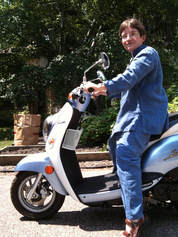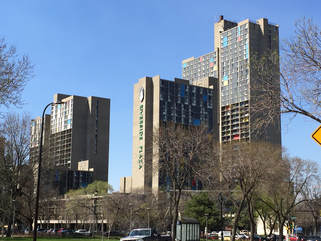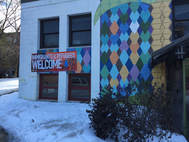Learn more:
About the Writer

When I accepted the Call to Trinity Lutheran Congregation in the Cedar-Riverside neighborhood of Minneapolis a friend and mentor asked with great care and affection if I would be wearing a bullet proof vest to my new office.
His question caught me off guard. Was that what people really thought of Cedar-Riverside? What had I gotten myself into? Or perhaps a more appropriate question would be – what had God gotten me into?
I didn’t realize at the time that Cedar-Riverside, knick-named Little Mogadishu, is the largest community of Somalis outside of Somalia. What had God gotten me into, indeed.
In the past twenty twoplus years I, standing at less than five feet tall with shoes on, have walked these streets, attended community gatherings, helped facilitate neighborhood vigils after crises and eaten more Sambusas and drunk more Somali tea than I ever would have imagined.
More importantly, I have come to understand that I have seen God in this community and its people time and again.
Growing up in the Lutheran Church – Missouri Synod I had learned to be suspicious of other faiths. As a child, I was pretty sure my best friend, a Catholic, was going to hell. Or so I had been taught. We were so certain that we had the right theology that even other branches of Lutherans were suspect.
Seeing God in Little Mogadishu has changed that, has changed me. These stories and reflections are about the experiences Trinity and I have had as we have accompanied this neighborhood, learning as we go. We have made mistakes and have experienced great joys along the way. These stories are about the work of the Holy Spirit as we have tried to listen to God, to the neighborhood and to each other.
Some people refer to me as Cedar-Riverside’s pastor. I hesitate to claim that title for myself. But I do know this place in this time has made me a better person, a better Christian, and a better pastor. For that gift I am grateful.
His question caught me off guard. Was that what people really thought of Cedar-Riverside? What had I gotten myself into? Or perhaps a more appropriate question would be – what had God gotten me into?
I didn’t realize at the time that Cedar-Riverside, knick-named Little Mogadishu, is the largest community of Somalis outside of Somalia. What had God gotten me into, indeed.
In the past twenty twoplus years I, standing at less than five feet tall with shoes on, have walked these streets, attended community gatherings, helped facilitate neighborhood vigils after crises and eaten more Sambusas and drunk more Somali tea than I ever would have imagined.
More importantly, I have come to understand that I have seen God in this community and its people time and again.
Growing up in the Lutheran Church – Missouri Synod I had learned to be suspicious of other faiths. As a child, I was pretty sure my best friend, a Catholic, was going to hell. Or so I had been taught. We were so certain that we had the right theology that even other branches of Lutherans were suspect.
Seeing God in Little Mogadishu has changed that, has changed me. These stories and reflections are about the experiences Trinity and I have had as we have accompanied this neighborhood, learning as we go. We have made mistakes and have experienced great joys along the way. These stories are about the work of the Holy Spirit as we have tried to listen to God, to the neighborhood and to each other.
Some people refer to me as Cedar-Riverside’s pastor. I hesitate to claim that title for myself. But I do know this place in this time has made me a better person, a better Christian, and a better pastor. For that gift I am grateful.
About the Neighborhood

Cedar-Riverside neighborhood of Minneapolis has long been a first stop for immigrants new to the United States. Once part of the Mni Sota Makoce, historic homeland of Dakota people, the 1850’s saw the beginning of many changes. Immigrants from Scandinavia and Europe began to come followed in the late 19th and early 20th centuries by immigrants from Asia. In the 1990’s Cedar-Riverside began to welcome immigrants from the Horn of Africa. The largest concentration of Somalis outside of Somalia now calls this neighborhood home. It is known by many as “Little Mogadishu.”
This rich history of diversity has made Cedar-Riverside a unique place to live, work, learn and play. Once known as a center of Scandinavian culture it also had a reputation for it Lutheran institutions. Today it is better known for its East African cultures and as a center for East African Muslims.
Those who are uninformed or misinformed think of this neighborhood as being very dangerous, and quite simply, scary. There are even some who believe Cedar-Riverside is ruled by Shari’a law. There is nothing further from the truth.
The stories in this blog tell of a very different truth about Cedar-Riverside.
Cedar-Riverside is complicated and wonderful, frustrating and beautiful. Those who have lived, worked, learned, played or prayed here find themselves changed. Many never leave and if they happen to move away, a part of themselves will always remain.
Many thanks to Anduin Wilhide for her summary of Cedar-Riverside’s history.
For more information about the history of Cedar-Riverside go to: http://digitours.augsburg.edu/tours/show/1
This rich history of diversity has made Cedar-Riverside a unique place to live, work, learn and play. Once known as a center of Scandinavian culture it also had a reputation for it Lutheran institutions. Today it is better known for its East African cultures and as a center for East African Muslims.
Those who are uninformed or misinformed think of this neighborhood as being very dangerous, and quite simply, scary. There are even some who believe Cedar-Riverside is ruled by Shari’a law. There is nothing further from the truth.
The stories in this blog tell of a very different truth about Cedar-Riverside.
Cedar-Riverside is complicated and wonderful, frustrating and beautiful. Those who have lived, worked, learned, played or prayed here find themselves changed. Many never leave and if they happen to move away, a part of themselves will always remain.
Many thanks to Anduin Wilhide for her summary of Cedar-Riverside’s history.
For more information about the history of Cedar-Riverside go to: http://digitours.augsburg.edu/tours/show/1
About Trinity Lutheran Congregation

Trinity Lutheran Congregation, officially founded by Norwegian and Danish immigrants on April 6, 1868, is one of Cedar-Riverside's oldest institutions. By 1902, it was the largest Norwegian Lutheran church in Minneapolis and worshiped in a sanctuary that could seat 1,000 people.
Things changed. In 1966 Trinity began its years as a nomadic congregation after its building was torn down to make way for I-94. Sensing a calling to stay in Cedar-Riverside, for the next twenty plus years Trinity worshiped and had offices in variety of places throughout the neighborhood. In 1989 Augsburg College invited Trinity to worship in its newly built Hoversten Chapel.
Today, on Sundays Trinity worships in the Augsburg Chapel and uses classrooms for an education hour. During the week Trinity operates out of a small building on the corner of Riverside and 20th Avenues. Trinity’s members today include descendants of Norwegians immigrants and newer immigrants from Eritrea and Ethiopia.
Our Mission statement is: “Nurturing Wholeness and Holiness in Cedar-Riverside.” As the only remaining Christian congregation in this neighborhood of more than 8,000 people we find ourselves in a new and rather unusual role. No longer are we simply a host for newcomers. We are also guests as we learn to be a Christian presence in the midst of people from a different land often with a different faith.
Trinity is small but mighty, finding its way in a new world we have called home for over 150 years. These posts tell some of the story.
Things changed. In 1966 Trinity began its years as a nomadic congregation after its building was torn down to make way for I-94. Sensing a calling to stay in Cedar-Riverside, for the next twenty plus years Trinity worshiped and had offices in variety of places throughout the neighborhood. In 1989 Augsburg College invited Trinity to worship in its newly built Hoversten Chapel.
Today, on Sundays Trinity worships in the Augsburg Chapel and uses classrooms for an education hour. During the week Trinity operates out of a small building on the corner of Riverside and 20th Avenues. Trinity’s members today include descendants of Norwegians immigrants and newer immigrants from Eritrea and Ethiopia.
Our Mission statement is: “Nurturing Wholeness and Holiness in Cedar-Riverside.” As the only remaining Christian congregation in this neighborhood of more than 8,000 people we find ourselves in a new and rather unusual role. No longer are we simply a host for newcomers. We are also guests as we learn to be a Christian presence in the midst of people from a different land often with a different faith.
Trinity is small but mighty, finding its way in a new world we have called home for over 150 years. These posts tell some of the story.